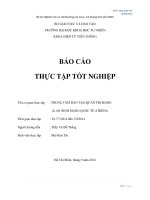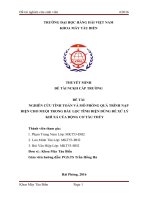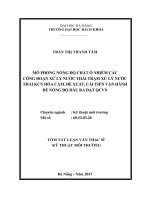Mô phỏng hiện tượng tán xạ cổ điển
Bạn đang xem bản rút gọn của tài liệu. Xem và tải ngay bản đầy đủ của tài liệu tại đây (5.68 MB, 75 trang )
1
Mô phỏng hiện tượng tán xạ cổ điển
• Vai trò của bài toán tán xạ trong Vật lý, vì sao nó quan
trọng?
- Trong các thí nghiệm Vật lý, ta rất cần biết rõ cấu trúc
của hệ cũng như các tính chất động lực của hệ, như
tương tác, v. v. Giải bài toán tán xạ sẽ cung cấp cho
chúng ta những thông tin này về hệ
Bài toán tán xạ cổ điển: Lý thuyết
• Tại sao phải giải số?
• Hầu như các quá trình tán xạ thực đều không có
nghiệm giải tích chính xác do dạng của thế phức tạp.
Chính vì vậy chúng ta phải giải số (mô phỏng)
• Đặt bài toán:
- Giả sử có một chùm hạt với vận tốc v, bay đến một bia
tại O dọc theo trục x (từ phía bên trái). Ví dụ: ở kích
thước nhỏ micro, chùm hạt có thể là proton, neutron
trong hạt nhân. Ở kích thước lớn hơn cỡ thiên hà, nó có
thể là các hành tinh, v. v.
Bài toán tán xạ cổ điển: Lý thuyết
72 Numerical calculus
db
θ
∆φ
d θ
b
r
O
x
m
∆φ
Fig. 3.2 A sketch of the
scattering process of a
particle in a central
potential.
The total cross section of such a scattering process is given by
σ =
σ (θ) d, (3.64)
where σ (θ) is the differential cross section, or the probability of a particle’s
being found in the solid angle element d = 2π sin θ dθ at the deflection
angle θ.
If the particles are coming in with a flux density I (number of particles per
unit cross-sectional area per unit time), then the number of particles per unit
time within the range db of the impact parameter b is 2π Ibdb. Because all the
incoming particles in this area will go out in the solid angle element d with the
probability σ (θ), we have
2π Ibdb = I σ (θ) d, (3.65)
which gives the differential cross section as
σ (θ) =
b
sin θ
db
dθ
. (3.66)
The reason for taking the absolute value of db/dθ in the above equation is that
db/dθ can be positive or negative depending on the form of the potential and the
impact parameter. However, σ (θ) has to be positive because it is a probability.
We can relate this center-of-mass cross section to the cross section measured
in the laboratory through an inverse coordinate transformation of Eq. (3.57)
and Eq. (3.58), which relates r and r
c
back to r
1
and r
2
. We will not discuss
this transformation here; interested readers can find it in any standard advanced
mechanics textbook.
Numerical evaluation of the cross section
Because the interaction between two particles is described by a spherically sym-
metric potential, the angular momentum and the total energy of the system are
Bài toán tán xạ cổ điển: Lý thuyết
72 Numerical calculus
db
θ
∆φ
d θ
b
r
O
x
m
∆φ
Fig. 3.2 A sketch of the
scattering process of a
particle in a central
potential.
The total cross section of such a scattering process is given by
σ =
σ (θ) d, (3.64)
where σ (θ) is the differential cross section, or the probability of a particle’s
being found in the solid angle element d = 2π sin θ dθ at the deflection
angle θ.
If the particles are coming in with a flux density I (number of particles per
unit cross-sectional area per unit time), then the number of particles per unit
time within the range db of the impact parameter b is 2π Ibdb. Because all the
incoming particles in this area will go out in the solid angle element d with the
probability σ (θ), we have
2π Ibdb = I σ (θ) d, (3.65)
which gives the differential cross section as
σ (θ) =
b
sin θ
db
dθ
. (3.66)
The reason for taking the absolute value of db/dθ in the above equation is that
db/dθ can be positive or negative depending on the form of the potential and the
impact parameter. However, σ (θ) has to be positive because it is a probability.
We can relate this center-of-mass cross section to the cross section measured
in the laboratory through an inverse coordinate transformation of Eq. (3.57)
and Eq. (3.58), which relates r and r
c
back to r
1
and r
2
. We will not discuss
this transformation here; interested readers can find it in any standard advanced
mechanics textbook.
Numerical evaluation of the cross section
Because the interaction between two particles is described by a spherically sym-
metric potential, the angular momentum and the total energy of the system are
b: tham số va chạm
• Giả thiết rằng độ rộng của chùm hạt lớn hơn bia tại O rất
nhiều. Về mặt lý thuyết, bia sẽ có nhiều tâm tán xạ
nhưng chúng ta chỉ xem bia giống như 1 hạt đủ nhỏ để
tiện tính toán
• Giả thiết thêm rằng tán xạ là đàn hồi và tâm O đứng im
Bài toán tán xạ cổ điển: Lý thuyết
72 Numerical calculus
db
θ
∆φ
d θ
b
r
O
x
m
∆φ
Fig. 3.2 A sketch of the
scattering process of a
particle in a central
potential.
The total cross section of such a scattering process is given by
σ =
σ (θ) d, (3.64)
where σ (θ) is the differential cross section, or the probability of a particle’s
being found in the solid angle element d = 2π sin θ dθ at the deflection
angle θ.
If the particles are coming in with a flux density I (number of particles per
unit cross-sectional area per unit time), then the number of particles per unit
time within the range db of the impact parameter b is 2π Ibdb. Because all the
incoming particles in this area will go out in the solid angle element d with the
probability σ (θ), we have
2π Ibdb = I σ (θ) d, (3.65)
which gives the differential cross section as
σ (θ) =
b
sin θ
db
dθ
. (3.66)
The reason for taking the absolute value of db/dθ in the above equation is that
db/dθ can be positive or negative depending on the form of the potential and the
impact parameter. However, σ (θ) has to be positive because it is a probability.
We can relate this center-of-mass cross section to the cross section measured
in the laboratory through an inverse coordinate transformation of Eq. (3.57)
and Eq. (3.58), which relates r and r
c
back to r
1
and r
2
. We will not discuss
this transformation here; interested readers can find it in any standard advanced
mechanics textbook.
Numerical evaluation of the cross section
Because the interaction between two particles is described by a spherically sym-
metric potential, the angular momentum and the total energy of the system are
b: tham số va chạm
• Cũng giả thiết rằng, không có hạt nào bị tán xạ qúa 1
lần. Đồng thời, xem rằng các hạt có tốc độ trước và sau
tán xạ như nhau
• Do tương tác của bia và hạt, hạt sẽ bị tán xạ. Do vậy, có
sự phụ thuộc của góc tán xạ 𝜃 vào tham số b
Bài toán tán xạ cổ điển: Lý thuyết
72 Numerical calculus
db
θ
∆φ
d θ
b
r
O
x
m
∆φ
Fig. 3.2 A sketch of the
scattering process of a
particle in a central
potential.
The total cross section of such a scattering process is given by
σ =
σ (θ ) d, (3.64)
where σ(θ) is the differential cross section, or the probability of a particle’s
being found in the solid angle element d = 2π sin θ dθ at the deflection
angle θ.
If the particles are coming in with a flux density I (number of particles per
unit cross-sectional area per unit time), then the number of particles per unit
time within the range db of the impact parameter b is 2π Ibdb. Because all the
incoming par ticles in this area will go out in the solid angle element d with the
probability σ (θ ), we have
2π Ibdb = Iσ (θ ) d, (3.65)
which gives the differential cross section as
σ (θ ) =
b
sin θ
db
dθ
. (3.66)
The reason for taking the absolute value of db/dθ in the above equation is that
db/dθ can be positive or negative depending on the form of the potential and the
impact parameter. However, σ (θ ) has to be positive because it is a probability.
We can relate this center-of-mass cross section to the cross section measured
in the laboratory through an inverse coordinate transformation of Eq. (3.57)
and Eq. (3.58), which relates r and r
c
back to r
1
and r
2
. We will not discuss
this transformation here; interested readers can find it in any standard advanced
mechanics textbook.
Numerical evaluation of the cross section
Because the interaction between two particles is described by a spherically sym-
metric potential, the angular momentum and the total energy of the system are
b: tham số va chạm
• Do tương tác của bia và hạt, hạt sẽ bị tán xạ. Vậy, có sự
phụ thuộc của góc tán xạ 𝜃 vào tham số b
• Hạt tán xạ sẽ được ghi lại bằng detector. Các detector sẽ
đếm được số hạt bị tán xạ trong một góc khối
dΩ = sin𝜃 d𝜃 dΦ
• Tiết diện tán xạ vi phân có mối liên hệ với các hạt đo
được bởi detector như sau:
Với: dN là số hạt tán xạ trong góc khối dΩ, N là tổng số
hạt và n là mật độ của bia trên một đơn vị diện tích
Bài toán tán xạ cổ điển: Lý thuyết
72 Numerical calculus
db
θ
∆φ
d θ
b
r
O
x
m
∆φ
Fig. 3.2 A sketch of the
scattering process of a
particle in a central
potential.
The total cross section of such a scattering process is given by
σ =
σ (θ ) d, (3.64)
where σ(θ) is the differential cross section, or the probability of a particle’s
being found in the solid angle element d = 2π sin θ dθ at the deflection
angle θ.
If the particles are coming in with a flux density I (number of particles per
unit cross-sectional area per unit time), then the number of particles per unit
time within the range db of the impact parameter b is 2π Ibdb. Because all the
incoming par ticles in this area will go out in the solid angle element d with the
probability σ (θ ), we have
2π Ibdb = Iσ (θ ) d, (3.65)
which gives the differential cross section as
σ (θ ) =
b
sin θ
db
dθ
. (3.66)
The reason for taking the absolute value of db/dθ in the above equation is that
db/dθ can be positive or negative depending on the form of the potential and the
impact parameter. However, σ (θ ) has to be positive because it is a probability.
We can relate this center-of-mass cross section to the cross section measured
in the laboratory through an inverse coordinate transformation of Eq. (3.57)
and Eq. (3.58), which relates r and r
c
back to r
1
and r
2
. We will not discuss
this transformation here; interested readers can find it in any standard advanced
mechanics textbook.
Numerical evaluation of the cross section
Because the interaction between two particles is described by a spherically sym-
metric potential, the angular momentum and the total energy of the system are
b: tham số va chạm
dN
N
= n(✓)d⌦
Bài toán tán xạ cổ điển: Lý thuyết
72 Numerical calculus
db
θ
∆φ
d θ
b
r
O
x
m
∆φ
Fig. 3.2 A sketch of the
scattering process of a
particle in a central
potential.
The total cross section of such a scattering process is given by
σ =
σ (θ) d, (3.64)
where σ (θ) is the differential cross section, or the probability of a particle’s
being found in the solid angle element d = 2π sin θ dθ at the deflection
angle θ.
If the particles are coming in with a flux density I (number of particles per
unit cross-sectional area per unit time), then the number of particles per unit
time within the range db of the impact parameter b is 2π Ibdb. Because all the
incoming particles in this area will go out in the solid angle element d with the
probability σ (θ), we have
2π Ibdb = I σ (θ ) d, (3.65)
which gives the differential cross section as
σ (θ) =
b
sin θ
db
dθ
. (3.66)
The reason for taking the absolute value of db/dθ in the above equation is that
db/dθ can be positive or negative depending on the form of the potential and the
impact parameter. However, σ (θ) has to be positive because it is a probability.
We can relate this center-of-mass cross section to the cross section measured
in the laboratory through an inverse coordinate transformation of Eq. (3.57)
and Eq. (3.58), which relates r and r
c
back to r
1
and r
2
. We will not discuss
this transformation here; interested readers can find it in any standard advanced
mechanics textbook.
Numerical evaluation of the cross section
Because the interaction between two particles is described by a spherically sym-
metric potential, the angular momentum and the total energy of the system are
b: tham số va chạm
• Nhiệm vụ của chúng ta là tính được tiết diện
tán xạ vi phân σ(𝜃)
dN
N
= n(✓)d⌦
Bài toán hai hạt
• Bài toán tán xạ có thể được hiểu như là sự tổng hợp của
các quá trình tán xạ giữa hai hạt. Vì vậy, ta có thể khảo sát
tán xạ của riêng hai hạt.
L =
m
1
2
v
2
1
+
m
2
2
v
2
2
V (r
1
, r
2
)
• Lagrangian cho hệ hai hạt tổng quát:
• Trong đó:
v
i
= |
dr
i
dt
|
; i = 1, 2
V (r
1
, r
2
)=V (r
12
)
r
12
= |r
2
r
1
|
• Với giả thiết thế tương tác V có tính đối xứng cầu:
Khoảng cách giữa hai hạt:
Bài toán tán xạ cổ điển
r
c
=
m
1
r
1
+ m
2
r
2
m
1
+ m
2
r = r
2
r
1
• Chúng ta có thể sử dụng toạ độ tương đối và toạ độ
khối tâm nhờ phép biến đổi sau:
L =
M
2
v
2
c
+
m
2
v
2
V (r)
• Lagrangian của hệ trở thành:
r = r
12
v = |
dr
dt
|
M = m
1
+ m
2
m =
m
1
m
2
m
1
+ m
2
• Với:
v
c
=
dr
c
dt
=0
• Nếu ta khảo cđ của hệ với điều kiện
• Bài toán đưa về bài toán 1 hạt cđ trong thế V(r)
• Từ định luật III Newton ta có:
f
1
= f
2
Bài toán tán xạ cổ điển
m
1
¨
r
1
= f
1
m
2
¨
r
2
= f
2
• Chúng ta có thể thu được kết luận tương tự khi áp dụng
phương trình định luật II Newton:
¨
r
i
=
d
2
r
i
dt
2
f
i
= r
i
V (r
21
)=
dV (r
21
)
dr
i
• Trong đó, gia tốc và lực như sau:
Bài toán tán xạ cổ điển
m
¨
r = f (r)
M
¨
r
c
=0
• Ta thu được hệ phương trình sau:
f (r)=rV (r)=
dV (r)
dr
• Trong đó:
• Như vậy, chuyển động của hệ 2 hạt tương
đương với chuyển động đều của khối tâm +
chuyển động của một hạt “hiệu dụng” trong
thế V(r)
Tiết diện tán xạ
72 Numerical calculus
db
θ
∆φ
d θ
b
r
O
x
m
∆φ
Fig. 3.2 A sketch of the
scattering process of a
particle in a central
potential.
The total cross section of such a scattering process is given by
σ =
σ (θ) d, (3.64)
where σ (θ) is the differential cross section, or the probability of a par ticle’s
being found in the solid angle element d = 2π sin θ dθ at the deflection
angle θ.
If the particles are coming in with a flux density I (number of particles per
unit cross-sectional area per unit time), then the number of particles per unit
time within the range db of the impact parameter b is 2π Ibdb. Because all the
incoming particles in this area will go out in the solid angle element d with the
probability σ (θ), we have
2π Ibdb = I σ (θ) d, (3.65)
which gives the differential cross section as
σ (θ) =
b
sin θ
db
dθ
. (3.66)
The reason for taking the absolute value of db/dθ in the above equation is that
db/dθ can be positive or negative depending on the form of the potential and the
impact parameter. However, σ (θ) has to be positive because it is a probability.
We can relate this center-of-mass cross section to the cross section measured
in the laboratory through an inverse coordinate transformation of Eq. (3.57)
and Eq. (3.58), which relates r and r
c
back to r
1
and r
2
. We will not discuss
this transformation here; interested readers can find it in any standard advanced
mechanics textbook.
Numerical evaluation of the cross section
Because the interaction between two particles is described by a spherically sym-
metric potential, the angular momentum and the total energy of the system are
• Nhiệm vụ của chúng ta là tính được tiết diện tán xạ
vi phân σ(𝜃)
• Tiết diện tán xạ tổng cộng:
=
Z
(✓)d⌦
• Góc khối vi phân:
d⌦ =2⇡sin✓d✓
• Giả sử chùm hạt đang đến có cường độ I (số hạt trên một
đơn vị diện tích) thì số hạt trong một đơn vị thời gian
trong khoảng vi phân db sẽ là: 2𝞹Ibdb. Toàn bộ chùm hạt
sẽ bị tán xạ trong góc khối dΩ với xác xuất σ(𝜃). Do đó ta
có:
2⇡Ibdb = I(✓)d⌦
Tiết diện tán xạ
(✓)=
b
sin✓
|
db
d✓
|
• Tiết diện tán xạ vi phân:
Tiết diện tán xạ (Tính toán số)
d
dr
=
d
dt
dt
dr
• Ta lại có:
E =
m
2
v
2
0
=
m
2
(˙r
2
+ r
2
˙
2
)+V (r)
• Năng lượng của toàn hệ (bảo toàn):
ϕ là góc trong toạ độ cực
l = mbv
0
= mr
2
˙
• Mômen động lượng (bảo toàn):
v
0
là vận tốc ban đầu
?
˙r =
dr
dt
=
s
2
m
✓
E
l
2
2mr
2
V (r)
◆
˙
=
d
dt
=
bv
0
r
2
=
b
r
2
r
2E
m
Tiết diện tán xạ (Tính toán số)
d
dr
=
d
dt
dt
dr
• Tính:
v
0
=
r
2E
m
d
dr
Thay vào tìm
Tiết diện tán xạ (Tính toán số)
• Nên:
d
dr
= ±
b
r
2
p
1 b
2
/r
2
V (r)/E
• Tìm ϕ thế nào?
E =
m
2
v
2
0
=
m
2
(˙r
2
+ r
2
˙
2
)+V (r)
• Năng lượng của toàn hệ (bảo toàn):
ϕ là góc trong toạ độ cực
l = mbv
0
= mr
2
˙
• Mômen động lượng (bảo toàn):
v
0
là vận tốc ban đầu
Tiết diện tán xạ
72 Numerical calculus
db
θ
∆φ
d θ
b
r
O
x
m
∆φ
Fig. 3.2 A sketch of the
scattering process of a
particle in a central
potential.
The total cross section of such a scattering process is given by
σ =
σ (θ) d, (3.64)
where σ (θ) is the differential cross section, or the probability of a par ticle’s
being found in the solid angle element d = 2π sin θ dθ at the deflection
angle θ.
If the particles are coming in with a flux density I (number of particles per
unit cross-sectional area per unit time), then the number of particles per unit
time within the range db of the impact parameter b is 2π Ibdb. Because all the
incoming particles in this area will go out in the solid angle element d with the
probability σ (θ), we have
2π Ibdb = I σ (θ) d, (3.65)
which gives the differential cross section as
σ (θ) =
b
sin θ
db
dθ
. (3.66)
The reason for taking the absolute value of db/dθ in the above equation is that
db/dθ can be positive or negative depending on the form of the potential and the
impact parameter. However, σ (θ) has to be positive because it is a probability.
We can relate this center-of-mass cross section to the cross section measured
in the laboratory through an inverse coordinate transformation of Eq. (3.57)
and Eq. (3.58), which relates r and r
c
back to r
1
and r
2
. We will not discuss
this transformation here; interested readers can find it in any standard advanced
mechanics textbook.
Numerical evaluation of the cross section
Because the interaction between two particles is described by a spherically sym-
metric potential, the angular momentum and the total energy of the system are
• Dấu + và - tương đương với hai phần khác nhau của quỹ
đạo
Tiết diện tán xạ (Tính toán số)
= b
Z
1
r
m
dr
r
2
p
1 b
2
/r
2
V ( r)/E
= b
Z
r
m
1
dr
r
2
p
1 b
2
/r
2
V ( r)/E
• Sự thay đổi trong toạ độ cực :
Trong đó, r
m
là khoảng cách cực tiểu giữa hạt và bia
Tiết diện tán xạ
72 Numerical calculus
db
θ
∆φ
d θ
b
r
O
x
m
∆φ
Fig. 3.2 A sketch of the
scattering process of a
particle in a central
potential.
The total cross section of such a scattering process is given by
σ =
σ (θ) d, (3.64)
where σ (θ) is the differential cross section, or the probability of a par ticle’s
being found in the solid angle element d = 2π sin θ dθ at the deflection
angle θ.
If the particles are coming in with a flux density I (number of particles per
unit cross-sectional area per unit time), then the number of particles per unit
time within the range db of the impact parameter b is 2π Ibdb. Because all the
incoming particles in this area will go out in the solid angle element d with the
probability σ (θ), we have
2π Ibdb = I σ (θ) d, (3.65)
which gives the differential cross section as
σ (θ) =
b
sin θ
db
dθ
. (3.66)
The reason for taking the absolute value of db/dθ in the above equation is that
db/dθ can be positive or negative depending on the form of the potential and the
impact parameter. However, σ (θ) has to be positive because it is a probability.
We can relate this center-of-mass cross section to the cross section measured
in the laboratory through an inverse coordinate transformation of Eq. (3.57)
and Eq. (3.58), which relates r and r
c
back to r
1
and r
2
. We will not discuss
this transformation here; interested readers can find it in any standard advanced
mechanics textbook.
Numerical evaluation of the cross section
Because the interaction between two particles is described by a spherically sym-
metric potential, the angular momentum and the total energy of the system are
✓ = ⇡ 2
• Từ đây ta có thể tính góc tán xạ
Tiết diện tán xạ (Tính toán số)
= b
Z
1
r
m
dr
r
2
p
1 b
2
/r
2
V ( r)/E
= b
Z
r
m
1
dr
r
2
p
1 b
2
/r
2
V ( r)/E
• Sự thay đổi trong toạ độ cực :
Trong đó, r
m
là khoảng cách cực tiểu giữa hạt và bia
Xác đinh r
m
như thế nào?
• Từ điều kiện:
˙r =0
• Vì: cho trường hợp
= ⇡/2
V (r)=0
Tiết diện tán xạ (Tính toán số)
1
b
2
r
2
m
V (r
m
)
E
=0
1.Tìm nghiệm
• Và định luật bảo toàn năng lượng và mômen động lượng
✓ = ⇡ 2
?
72 Numerical calculus
db
θ
∆φ
d θ
b
r
O
x
m
∆φ
Fig. 3.2 A sketch of the
scattering process of a
particle in a central
potential.
The total cross section of such a scattering process is given by
σ =
σ (θ) d, (3.64)
where σ (θ) is the differential cross section, or the probability of a particle’s
being found in the solid angle element d = 2π sin θ dθ at the deflection
angle θ.
If the particles are coming in with a flux density I (number of particles per
unit cross-sectional area per unit time), then the number of particles per unit
time within the range db of the impact parameter b is 2π Ibdb. Because all the
incoming particles in this area will go out in the solid angle element d with the
probability σ (θ), we have
2π Ibdb = I σ (θ) d, (3.65)
which gives the differential cross section as
σ (θ) =
b
sin θ
db
dθ
. (3.66)
The reason for taking the absolute value of db/dθ in the above equation is that
db/dθ can be positive or negative depending on the form of the potential and the
impact parameter. However, σ(θ) has to be positive because it is a probability.
We can relate this center-of-mass cross section to the cross section measured
in the laboratory through an inverse coordinate transformation of Eq. (3.57)
and Eq. (3.58), which relates r and r
c
back to r
1
and r
2
. We will not discuss
this transformation here; interested readers can find it in any standard advanced
mechanics textbook.
Numerical evaluation of the cross section
Because the interaction between two particles is described by a spherically sym-
metric potential, the angular momentum and the total energy of the system are
⇡ =2b
Z
1
b
dr
r
2
p
1 b
2
/r
2
Tiết diện tán xạ (Tính toán số)
✓ =2b
"
Z
1
b
dr
r
2
p
1 b
2
/r
2
Z
1
r
m
dr
r
2
p
1 b
2
/r
2
V (r)/E
#
2. Tính tích phân
• Ta suy ra:
• Viết lại
•
Viết lại 𝞹 là một kỹ thuật mô phỏng để giảm thiểu sai số.
Sai số do cận trên của tích tích phân của hai số hạng trên sẽ
triệt tiêu nhau
Tiết diện tán xạ (Tính toán số)
3. Tính đạo hàm
✓ =2b
"
Z
1
b
dr
r
2
p
1 b
2
/r
2
Z
1
r
m
dr
r
2
p
1 b
2
/r
2
V (r)/E
#
(✓)=
b
sin✓
|
db
d✓
|
• Tiết diện tán xạ vi phân
Tiết diện tán xạ (Tính toán số)
• Áp dụng vào một trường hợp cụ thể là thế Coulomb
(thế Yukawa):
(✓)=
⇣
4E
⌘
2
1
sin
4
(✓/2)
V (r)=
r
e
r/a









